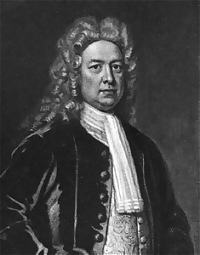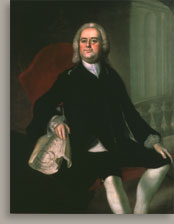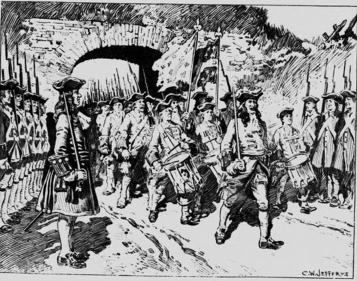|
Peregrine Thomas Hopson
Peregrine Thomas Hopson (5 June 1696 – 27 February 1759) was a British army officer who commanded the 40th Regiment of Foot and saw extensive service during the eighteenth century and rose to the rank of Major General. He also served as British commander in Louisbourg during the British occupation between 1746–1749, then became Governor of Nova Scotia and later led a major expedition to the West Indies during the Seven Years' War during which he died. Hopson is perhaps best known for signing the Peace Treaty of 1752 the Edward Cornwallis created with Mi'kmaq chief Jean-Baptiste Cope which is celebrated (along with other treaties) every year by Nova Scotians on Treaty Day. Early career Hopson was born on 5 June 1696, the second son of vice admiral Sir Thomas Hopsonn and Elizabeth Timbrell. He initially joined the Royal Marines in 1703, but later transferred to join the British Army. He rose his way up to Lieutenant Colonel by 1743, serving mainly in Gibraltar. Louisbourg ... [...More Info...] [...Related Items...] OR: [Wikipedia] [Google] [Baidu] |
Gibraltar
) , anthem = " God Save the King" , song = " Gibraltar Anthem" , image_map = Gibraltar location in Europe.svg , map_alt = Location of Gibraltar in Europe , map_caption = United Kingdom shown in pale green , mapsize = , image_map2 = Gibraltar map-en-edit2.svg , map_alt2 = Map of Gibraltar , map_caption2 = Map of Gibraltar , mapsize2 = , subdivision_type = Sovereign state , subdivision_name = , established_title = British capture , established_date = 4 August 1704 , established_title2 = , established_date2 = 11 April 1713 , established_title3 = National Day , established_date3 = 10 September 1967 , established_title4 = Accession to EEC , established_date4 = 1 January 1973 , established_title5 = Withdrawal from the EU , established_date5 = 31 January 2020 , official_languages = English , languages_type = Spoken languages , languages = , capital = Westside, Gibraltar (de facto) , coordinates = , largest_settlement_type = largest district , l ... [...More Info...] [...Related Items...] OR: [Wikipedia] [Google] [Baidu] |
John Barrington (British Army Officer)
Major-General John Barrington (c. 1722 – 2 April 1764) was an officer of the British Army, the third son of John Barrington, 1st Viscount Barrington. Early life He was the second son of John Barrington, 1st Viscount Barrington and Anne (née Daines) Barrington (a daughter and co-heiress of Sir William Daines MP, Mayor of Bristol). Among his siblings was older brother William, who served as the Chancellor of the Exchequer and became the 2nd Viscount Barrington upon their father's death in 1734. His younger brothers included Daines Barrington, a lawyer, antiquarian and naturalist; Rear-Admiral Samuel Barrington of the Royal Navy; and Shute Barrington who became Bishop of Salisbury and Bishop of Durham. Career He served in the 3rd Foot Guards, and in 1746, he obtained the commission of Captain-lieutenant in the 2nd Foot Guards, in which corps he was promoted to the rank of Captain and Lieutenant-colonel in 1748. In 1756, he was promoted to the rank of Colonel, and appointe ... [...More Info...] [...Related Items...] OR: [Wikipedia] [Google] [Baidu] |
George II Of Great Britain
, house = Hanover , religion = Protestant , father = George I of Great Britain , mother = Sophia Dorothea of Celle , birth_date = 30 October / 9 November 1683 , birth_place = Herrenhausen Palace,Cannon. or Leine Palace, Hanover , death_date = , death_place = Kensington Palace, London, England , burial_date = 11 November 1760 , burial_place = Westminster Abbey, London , signature = Firma del Rey George II.svg , signature_alt = George's signature in cursive George II (George Augustus; german: link=no, Georg August; 30 October / 9 November 1683 – 25 October 1760) was King of Great Britain and Ireland, Duke of Brunswick-Lüneburg (Hanover) and a prince-elector of the Holy Roman Empire from 11 June 1727 ( O.S.) until his death in 1760. Born and brought up in northern Germany, George is the most recent British monarch born outside Great Britain. The Act of Settlement 1701 and the Acts of Union 1707 positioned his grandmother, ... [...More Info...] [...Related Items...] OR: [Wikipedia] [Google] [Baidu] |
William Pitt, 1st Earl Of Chatham
William Pitt, 1st Earl of Chatham, (15 November 170811 May 1778) was a British statesman of the Whig group who served as Prime Minister of Great Britain from 1766 to 1768. Historians call him Chatham or William Pitt the Elder to distinguish him from his son William Pitt the Younger, who was also a prime minister. Pitt was also known as the Great Commoner, because of his long-standing refusal to accept a title until 1766. Pitt was a member of the British cabinet and its informal leader from 1756 to 1761 (with a brief interlude in 1757), during the Seven Years' War (including the French and Indian War in the American colonies). He again led the ministry, holding the official title of Lord Privy Seal, between 1766 and 1768. Much of his power came from his brilliant oratory. He was out of power for most of his career and became well known for his attacks on the government, such as those on Walpole's corruption in the 1730s, Hanoverian subsidies in the 1740s, peace with France ... [...More Info...] [...Related Items...] OR: [Wikipedia] [Google] [Baidu] |
Siege Of Louisbourg (1758)
The siege of Louisbourg was a pivotal operation of the Seven Years' War (known in the United States as the French and Indian War) in 1758 that ended the French colonial era in Atlantic Canada and led to the subsequent British campaign to capture Quebec in 1759 and the remainder of French North America the following year. Background The British government realized that with the Fortress of Louisbourg under French control, the Royal Navy could not sail up the St. Lawrence River unmolested for an attack on Quebec. After an expedition against Louisbourg in 1757 led by Lord Loudon was turned back due to a strong French naval deployment, the British under the leadership of William Pitt resolved to try again with new commanders. Pitt assigned the task of capturing the fortress to Major General Jeffery Amherst. Amherst's brigadiers were Charles Lawrence, James Wolfe and Edward Whitmore, and command of naval operations was assigned to Admiral Edward Boscawen. The chief engineer w ... [...More Info...] [...Related Items...] OR: [Wikipedia] [Google] [Baidu] |
Great Upheaval
The Expulsion of the Acadians, also known as the Great Upheaval, the Great Expulsion, the Great Deportation, and the Deportation of the Acadians (french: Le Grand Dérangement or ), was the forced removal, by the British, of the Acadian people from parts of a Canadian-American region historically known as ''Acadia'', between 1755–1764. The area included the present-day Canadian Maritime provinces of Nova Scotia, New Brunswick, and Prince Edward Island, and the present-day U.S. state of Maine. The Expulsion, which caused the deaths of thousands of people, occurred during the French and Indian War (the North American theatre of the Seven Years' War) and was part of the British military campaign against New France. The British first deported Acadians to the Thirteen Colonies, and after 1758, transported additional Acadians to Britain and France. In all, of the 14,100 Acadians in the region, approximately 11,500 were deported, at least 5,000 Acadians died of disease, starvat ... [...More Info...] [...Related Items...] OR: [Wikipedia] [Google] [Baidu] |
Attack At Isle Madame
The Attack at Jeddore happened on May 19, 1753, off Jeddore, Nova Scotia, during Father Le Loutre's War. The Mi'kmaq killed nine of the British delegates and spared the life of the French-speaking translator Anthony Casteel, who wrote one of the few captivity narratives that exist from Acadia and Nova Scotia. Historical context Following the British Conquest of Acadia in 1710, Nova Scotia remained primarily occupied by Catholic Acadians and Mi'kmaq. By the time Cornwallis had arrived in Halifax, there was a long history of the Wabanaki Confederacy (which included the Mi'kmaq) resisting British colonial encroachment by launching raids on their settlements along the New England/ Acadia border in Maine (See the Northeast Coast Campaigns 1688, 1703, 1723, 1724, 1745, 1746, 1747). On 22 November 1752, after several years of fighting, the leader of the Shubenacadie Mi'kmaq village under the chief Jean-Baptiste Cope reached a peace agreement with Nova Scotia Governor Peregrine Hopson i ... [...More Info...] [...Related Items...] OR: [Wikipedia] [Google] [Baidu] |
Quebec
Quebec ( ; )According to the Canadian government, ''Québec'' (with the acute accent) is the official name in Canadian French and ''Quebec'' (without the accent) is the province's official name in Canadian English is one of the thirteen provinces and territories of Canada. It is the largest province by area and the second-largest by population. Much of the population lives in urban areas along the St. Lawrence River, between the most populous city, Montreal, and the provincial capital, Quebec City. Quebec is the home of the Québécois nation. Located in Central Canada, the province shares land borders with Ontario to the west, Newfoundland and Labrador to the northeast, New Brunswick to the southeast, and a coastal border with Nunavut; in the south it borders Maine, New Hampshire, Vermont, and New York in the United States. Between 1534 and 1763, Quebec was called ''Canada'' and was the most developed colony in New France. Following the Seven Years' War, Quebec b ... [...More Info...] [...Related Items...] OR: [Wikipedia] [Google] [Baidu] |
Halifax Regional Municipality
Halifax is the capital and largest municipality of the Provinces and territories of Canada, Canadian province of Nova Scotia, and the largest municipality in Atlantic Canada. As of the 2021 Census, the municipal population was 439,819, with 348,634 people in its urban area. The regional municipality consists of four former municipalities that were Amalgamation (politics), amalgamated in 1996: History of Halifax (former city), Halifax, Dartmouth, Nova Scotia, Dartmouth, Bedford, Nova Scotia, Bedford, and Halifax County, Nova Scotia, Halifax County. Halifax is a major economic centre in Atlantic Canada, with a large concentration of government services and private sector companies. Major employers and economic generators include the Canadian Armed Forces, Department of National Defence, Dalhousie University, Nova Scotia Health Authority, Saint Mary's University (Halifax), Saint Mary's University, the Halifax Shipyard, various levels of government, and the Port of Halifax. Agricult ... [...More Info...] [...Related Items...] OR: [Wikipedia] [Google] [Baidu] |
Governor Of Nova Scotia
The following is a list of the governors and lieutenant governors of Nova Scotia. Though the present day office of the lieutenant governor in Nova Scotia came into being only upon the province's entry into Canadian Confederation in 1867, the post is a continuation from the first governorship of Nova Scotia in 1710. For much of the time, the full title of the post was Governor of Nova Scotia and Placentia (Placentia being in Newfoundland). Before the British occupation of Nova Scotia, the province was governed by French Governors of Acadia. From 1784 to 1829 Cape Breton Island was a separate colony with a vice regal post. Governors of Nova Scotia, 1710–1786 Lieutenant governors of Cape Breton Island, 1784–1820 Lieutenant governors of Nova Scotia, 1786–1867 Lieutenant governors of Nova Scotia, 1867–present See also * Office-holders of Canada * Canadian incumbents by year External links * * References {{Nova Scotia politics * Nova Scotia Lieutenant gove ... [...More Info...] [...Related Items...] OR: [Wikipedia] [Google] [Baidu] |
Father Le Loutre's War
Father Le Loutre's War (1749–1755), also known as the Indian War, the Mi'kmaq War and the Anglo-Mi'kmaq War, took place between King George's War and the French and Indian War in Acadia and Nova Scotia. On one side of the conflict, the British and New England colonists were led by British officer Charles Lawrence and New England Ranger John Gorham. On the other side, Father Jean-Louis Le Loutre led the Mi'kmaq and the Acadia militia in guerrilla warfare against settlers and British forces. At the outbreak of the war there were an estimated 2500 Mi'kmaq and 12,000 Acadians in the region. While the British captured Port Royal in 1710 and were ceded peninsular Acadia in 1713, the Mi'kmaq and Acadians continued to contain the British in settlements at Port Royal and Canso. The rest of the colony was in the control of the Catholic Mi'kmaq and Acadians. About forty years later, the British made a concerted effort to settle Protestants in the region and to establish military ... [...More Info...] [...Related Items...] OR: [Wikipedia] [Google] [Baidu] |
_by_Dominic_Serres%2C_c._1765.jpg)

_und_ihre_Kinder_Georg_August_und_Sophie_Dorothea.jpg)






